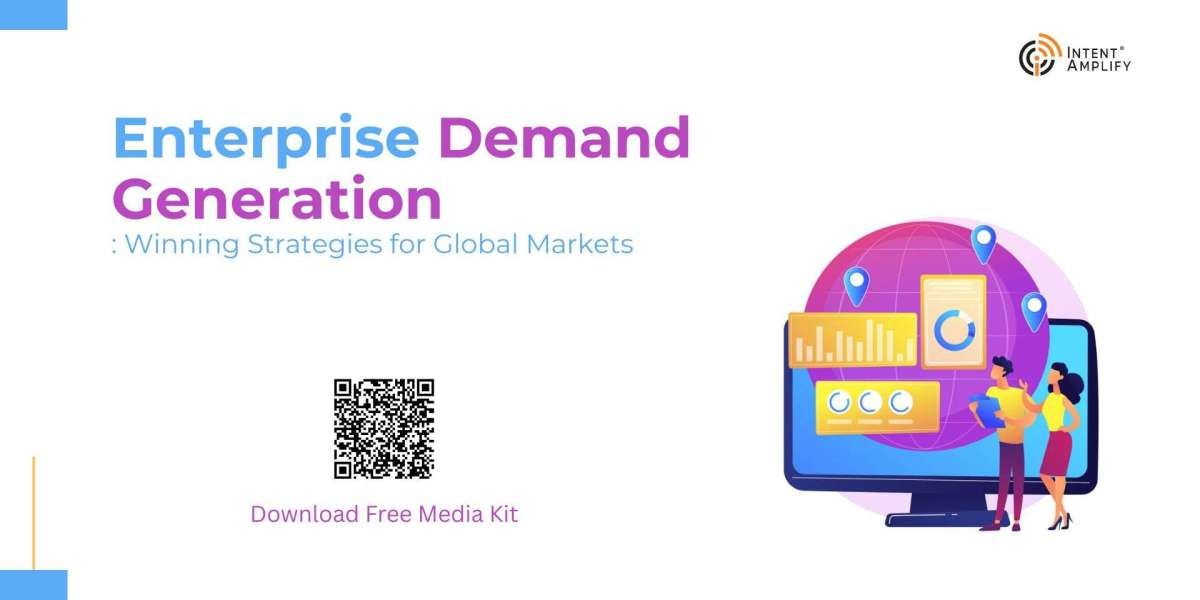Enterprise demand generation has evolved dramatically in recent years. Unlike small businesses that focus on basic lead generation tactics, enterprise companies require sophisticated, multi-layered strategies that can scale across global markets and diverse customer segments.
According to recent industry reports, enterprise companies that implement comprehensive demand generation strategies see 67% higher lead conversion rates compared to those using traditional methods. However, achieving these results requires understanding the unique challenges enterprises face in today's competitive landscape.
What Makes Enterprise Demand Generation Different?
Enterprise demand generation goes beyond simple brand awareness campaigns. Large organizations operate in complex ecosystems where buying decisions involve multiple stakeholders, longer sales cycles, and substantial investments.
Consider this: The average enterprise sale involves 6.8 decision-makers and takes 18 months to complete. Therefore, your demand generation strategy must nurture relationships across multiple touchpoints while maintaining consistent messaging throughout extended engagement periods.
Key Characteristics of Enterprise Demand Generation
Scale and Complexity: Enterprise companies target diverse markets simultaneously. They need strategies that work across different industries, geographic regions, and customer segments.
Resource Allocation: Unlike smaller businesses, enterprises have substantial marketing budgets but also face higher expectations for ROI measurement and accountability.
Stakeholder Management: Enterprise buying committees include technical evaluators, financial decision-makers, and end-users. Your demand generation must speak to each group effectively.
8 Proven Enterprise Demand Generation Strategies for 2025
1. Implement Advanced Account-Based Marketing (ABM)
Modern ABM goes beyond basic personalization. Today's enterprise demand generation requires hyper-targeted approaches that treat high-value accounts as individual markets.
Strategic Implementation Steps:
Start by identifying your ideal customer profile using predictive analytics and intent data. Focus on accounts showing active buying signals through their digital behavior patterns.
Create dedicated content journeys for each target account. This includes personalized landing pages, custom research reports, and tailored email sequences that address specific business challenges.
Deploy multi-channel orchestration across LinkedIn, email, direct mail, and targeted advertising. Coordinate messaging across all touchpoints to create cohesive account experiences.
Measuring ABM Success:
Track engagement velocity across multiple stakeholders within target accounts. Monitor content consumption patterns and meeting acceptance rates as leading indicators of pipeline development.
2. Leverage Intent Data for Proactive Engagement
Intent data reveals when prospects actively research solutions in your category. This intelligence enables proactive outreach when buyers enter active evaluation phases.
First-Party Intent Signals:
- Website behavior patterns and content consumption
- Webinar attendance and engagement levels
- Resource download frequencies and topics
Third-Party Intent Indicators:
- Research activity on industry publications
- Competitor comparison searches
- Solution-specific keyword patterns
Actionable Implementation:
Set up automated workflows that trigger personalized outreach when intent scores reach predetermined thresholds. Create content specifically designed to address the research topics generating intent signals.
Integrate intent data with your CRM to provide sales teams real-time insights about prospect engagement and buying stage indicators.
Download Our Free Enterprise Marketing Media Kit
Transform your demand generation strategy with our comprehensive media kit featuring:
- Enterprise buyer persona templates
- ROI calculation frameworks
- Campaign performance benchmarks
- Multi-channel orchestration guides
3. Build Content Ecosystems, Not Individual Assets
Enterprise buyers consume extensive content before making purchase decisions. Create interconnected content ecosystems that guide prospects through comprehensive evaluation processes.
Content Architecture Strategy:
Awareness Stage: Industry trend reports, market research, and thought leadership content that establishes your expertise without promoting specific solutions.
Consideration Stage: Solution comparison guides, ROI calculators, and case study collections that help prospects evaluate different approaches.
Decision Stage: Implementation guides, vendor evaluation criteria, and detailed product demonstrations that support final decision-making.
Customer Success Stage: Best practice guides, advanced use cases, and expansion opportunity content that drives account growth.
4. Orchestrate Multi-Channel Experiences
Enterprise prospects interact with your brand across numerous channels before making purchase decisions. Successful demand generation requires coordinated experiences across all touchpoints.
Channel Orchestration Framework:
Digital Advertising: Use programmatic advertising with account-based targeting to reach key stakeholders across their preferred online destinations.
Social Selling: Enable your sales team with social insights and content that supports relationship building on LinkedIn and industry-specific platforms.
Event Marketing: Create exclusive experiences for target accounts through private dinners, custom workshops, and VIP conference access.
Email Marketing: Develop sophisticated nurturing sequences that adapt based on engagement patterns and behavioral triggers.
Direct Outreach: Coordinate sales development efforts with marketing campaigns to ensure consistent messaging and optimal timing.
5. Implement Predictive Lead Scoring
Traditional lead scoring models fail to capture the complexity of enterprise buying patterns. Predictive scoring uses machine learning to identify high-probability opportunities more accurately.
Advanced Scoring Criteria:
Behavioral Indicators: Content engagement patterns, website navigation paths, and interaction frequency across multiple channels.
Firmographic Data: Company size, growth trajectory, technology stack, and competitive landscape position.
Technographic Signals: Current solution usage, implementation timelines, and technology adoption patterns.
Engagement Quality: Meeting acceptance rates, demo participation, and stakeholder involvement levels.
6. Create Executive-Level Thought Leadership
Enterprise buying decisions often require C-level approval. Therefore, your demand generation strategy must include content and experiences that resonate with senior executives.
Executive Engagement Tactics:
Develop exclusive research reports that provide industry insights relevant to executive strategic planning. Position your leadership team as industry experts through speaking opportunities and media interviews.
Host invitation-only executive roundtables focused on industry challenges rather than product promotion. These forums create valuable networking opportunities while demonstrating thought leadership.
Create executive briefing centers where prospects can experience custom presentations tailored to their specific business challenges and objectives.
7. Optimize for International Market Expansion
Enterprise companies often serve global markets requiring localized demand generation approaches. However, maintaining brand consistency across diverse markets presents significant challenges.
Global Strategy Components:
Cultural Adaptation: Research local business customs, communication preferences, and decision-making processes for each target market.
Regulatory Compliance: Ensure all marketing activities comply with local data privacy regulations, advertising standards, and industry requirements.
Language Localization: Translate content professionally and adapt messaging to reflect local market conditions and competitive landscapes.
Regional Partnerships: Collaborate with local partners, industry associations, and channel partners to extend market reach authentically.
8. Implement Advanced Marketing Attribution
Enterprise sales cycles involve multiple touchpoints across extended timeframes. Accurate attribution helps optimize budget allocation and campaign effectiveness.
Attribution Model Selection:
Time-Decay Attribution: Gives more credit to touchpoints closer to conversion, acknowledging that recent interactions often drive final decisions.
Position-Based Attribution: Credits first and last touchpoints heavily while distributing remaining attribution across middle interactions.
Data-Driven Attribution: Uses machine learning to assign credit based on actual influence patterns specific to your customer journey.
Multi-Touch Attribution: Tracks all interactions across the entire customer lifecycle, including post-purchase expansion opportunities.
How Do You Measure Enterprise Demand Generation Success?
Measuring enterprise demand generation requires sophisticated metrics that go beyond simple lead volume. Focus on quality indicators that correlate with actual revenue generation.
Pipeline Velocity Metrics:
- Average time to move between sales stages
- Stakeholder engagement progression rates
- Content consumption correlation with deal progression
Account Penetration Indicators:
- Number of engaged contacts per target account
- Stakeholder seniority levels in active conversations
- Cross-functional department engagement rates
Revenue Attribution Metrics:
- Marketing sourced pipeline value
- Marketing influenced deal velocity
- Customer lifetime value by acquisition channel
What Common Mistakes Should You Avoid?
Mistake #1: Treating all enterprise prospects identically despite significant differences in company size, industry, and buying process maturity.
Solution: Develop detailed segmentation strategies that account for industry-specific challenges, company growth stages, and technology adoption patterns.
Mistake #2: Focusing exclusively on new logo acquisition while ignoring expansion opportunities within existing accounts.
Solution: Create dedicated demand generation programs for account expansion, cross-selling, and upselling opportunities.
Mistake #3: Implementing technology solutions without proper data integration and workflow alignment.
Solution: Ensure all marketing technology connects seamlessly with your CRM and provides actionable insights for sales teams.
Technology Stack Requirements for Enterprise Demand Generation
Modern enterprise demand generation requires sophisticated technology integration. However, technology alone cannot replace strategic thinking and creative execution.
Essential Platform Categories
Marketing Automation: Advanced platforms like Marketo, Pardot, or HubSpot Enterprise that can handle complex nurturing sequences and behavioral triggers.
Intent Data Providers: Services like Bombora, G2, or TechTarget that provide insights into prospect research activities and buying signals.
ABM Platforms: Solutions like Demandbase, 6sense, or Terminus that enable account-based targeting and personalization at scale.
Analytics and Attribution: Tools like Bizible, Attribution, or custom dashboard solutions that provide accurate ROI measurement across multiple touchpoints.
Future Trends Shaping Enterprise Demand Generation
Artificial Intelligence and Machine Learning
AI continues transforming demand generation through predictive analytics, content personalization, and automated optimization. However, successful implementation requires high-quality data and clear success metrics.
Practical Applications:
- Predictive lead scoring that improves over time
- Dynamic content personalization based on behavioral patterns
- Automated campaign optimization across multiple channels
Privacy-First Marketing Strategies
Increasing privacy regulations require new approaches to data collection and audience targeting. Successful enterprises build first-party data strategies that provide insights while respecting customer privacy.
Implementation Strategies:
- Value exchange programs that encourage voluntary data sharing
- Progressive profiling techniques that gradually build customer understanding
- Consent management platforms that ensure regulatory compliance
Interactive Content Experiences
Static content no longer captures enterprise buyer attention effectively. Interactive experiences like assessments, calculators, and configurators provide value while generating qualified leads.
Engagement Formats:
- ROI calculators tailored to specific use cases
- Interactive product demonstrations
- Assessment tools that provide personalized recommendations
Selecting the Right Enterprise Demand Generation Partner
Most enterprises lack internal expertise to implement sophisticated demand generation strategies effectively. Therefore, selecting the right partner becomes critical for success.
Essential Partner Capabilities
Strategic Consulting: Look for partners who understand enterprise sales cycles and can develop comprehensive strategies rather than just tactical execution.
Technology Expertise: Ensure your partner has experience with enterprise-grade marketing technology and can integrate complex systems effectively.
Industry Knowledge: Choose partners with deep understanding of your industry's unique challenges, regulatory requirements, and competitive landscape.
Global Capabilities: If you serve international markets, verify that your partner can support localization and cultural adaptation requirements.
How Intent Amplify® Supports Enterprise Demand Generation
Intent Amplify® specializes in sophisticated demand generation strategies designed specifically for enterprise organizations. Our approach combines strategic consulting, advanced technology implementation, and creative execution to drive measurable results.
Our Unique Methodology:
We start every engagement with comprehensive market research and buyer journey mapping. This foundation ensures our strategies align with your prospects' actual decision-making processes.
Our team includes former enterprise sales professionals who understand the complexities of long sales cycles and multi-stakeholder buying committees. This experience shapes every campaign we develop.
We implement advanced attribution modeling that accurately measures marketing's contribution to pipeline development and revenue generation. This transparency enables continuous optimization and budget allocation decisions.
Service Capabilities:
- Account-based marketing strategy and execution
- Intent data integration and activation
- Multi-channel campaign orchestration
- Predictive lead scoring implementation
- Global market expansion support
Building Sustainable Enterprise Demand Generation
Enterprise demand generation success requires balancing sophisticated strategies with authentic relationship building. While technology enables scale and efficiency, human connections ultimately drive purchase decisions.
Focus on creating genuine value for your prospects throughout their buying journey. Provide insights, resources, and experiences that help them make better decisions, regardless of whether they choose your solution.
Remember that enterprise demand generation is a long-term investment. Building brand recognition, thought leadership, and customer relationships takes time but creates sustainable competitive advantages.
The enterprises that succeed in 2025 and beyond will be those that combine strategic thinking, advanced technology, and genuine customer focus to create exceptional buyer experiences.
Ready to Transform Your Enterprise Demand Generation?
Intent Amplify® helps enterprise organizations build sophisticated demand generation strategies that drive measurable results. Our team combines strategic expertise with advanced technology to create campaigns that resonate with your target accounts.
Schedule your free consultation today and discover how we can accelerate your pipeline development:
Our enterprise demand generation specialists will analyze your current approach and recommend specific improvements that can impact your results within 90 days.
Read Our Latest Blog
Measuring ABM ROI: Attribution Models Driven by Intent and Engagement Signals
What is The Psychology Behind B2B Buyer Decisions
How to Optimize Your Content for Google’s People Also Ask (PAA) Box
Contact Us:
1846 E Innovation Park Dr,
Suite 100, Oro Valley, AZ 85755
Phone: +1 (845) 347-8894, +91 77760 92666
Email: [email protected]



